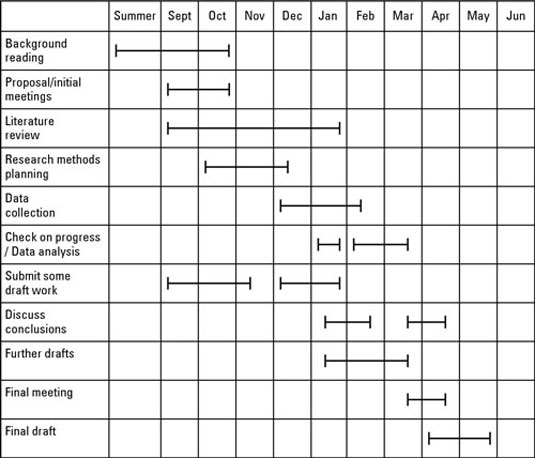Writing a dissertation is likely to be the biggest piece of work you’re going to tackle on your university course. To do your dissertation justice means spending a lot of your time and energy on your dissertation – and sometimes tears.
It need come as no surprise that you’re expected to write a dissertation as part of your course having been given all the information about your course when you first started. So there’s no reason for waiting until the first day of your last year to start thinking about it!
Most universities allow one academic year for students to complete their dissertation, but some university courses require a longer or shorter project. Whatever the timescale of your university or institution, a year stretching ahead of you can seem an age.
Anyone who’s done a dissertation tells you with glee that this is merely an illusion and you that you need to do some careful planning to make the best use of your time. Time has a way of evaporating like thin air – and all too soon the submission date is hanging over you like a dark cloud.
Be realistic about your dissertation deadline
Right – time for a reality check. How long is a year? ‘Twelve months’ I hear you say. ‘Nope, the year I’m talking about is four months long!’ I reply. ‘How so?’ you protest. ‘Well, it’s like this. . ’
Usually you have one academic year to write your dissertation. I say ‘academic year’ because an academic year is shorter than a calendar year. You probably start the academic year sometime between the middle of September and the middle of October, and you have to submit your finished dissertation (polished and perfect, completed and bound) in the following May or June. That’s actually about seven months in total.
Take out a few weeks for sickness, holidays and trips to the pub, and you have about six months. Now deduct the time you need for your other course work: essays, presentations and attending lectures. Also take off the hours a week you spend doing paid part-time work. On top of this subtract the time you need for keeping up with your family and friends, and the many groups you’re involved in that make inroads on the time you have for your dissertation.
Oh, and don’t forget – you also have to spend time eating and sleeping. Now – how long is a year?
Rather scarily, your ‘year’ may seem a lot less time than it first appeared. This doesn’t have to be a problem however. What you need to do is plan your time effectively and then manage your time well. The best way of managing your time is by having a timeline.
Create a dissertation timeline
A timeline is a schedule of events or a plan and it is presented chronologically. Your approach to your dissertation timeline depends on a number of factors such as your work space and whether you prefer ideas, for example, to be presented in a visual map or a linear list. A way of working out what is best for you is to think about how you like taking notes – straight prose, lists and numbered information, or using more organic lists with coloured diagrams, linked together with arrows?
You may like to create a table with overlapping lines called a Gantt chart, showing the different tasks you’ve set yourself and how the tasks run alongside one another. You can see an example of a Gantt chart in the following figure.

Make contingency plans for dissertation writing
Sometimes you find your careful plans for managing your dissertation going pear-shaped. You need to be able to cope with setbacks and salvage what you can. Aim to complete each task as early on as possible so that you have time to make any necessary changes.
You can help yourself by building enough time into your dissertation timetable to allow for mini disasters and keeping ahead of the game so that any crises don’t slow you up too much. The plans you make when crises occur differ depending on what you need to change or develop.
At this stage, you can think about what you’d most like to get done, but also think of an alternative if you run into difficulties. For example, you may prefer to distribute your questionnaire to 50 students at your university but your contingency plan would be to add up all the friends and acquaintances you have from the classes and clubs you attend and see if that would be a reasonable sample.
You may try asking a tutor if you can give out your questionnaire during a taught session. It would mean reducing your ideal number from 50 to, say, 25, but at least you have some data you can use.

